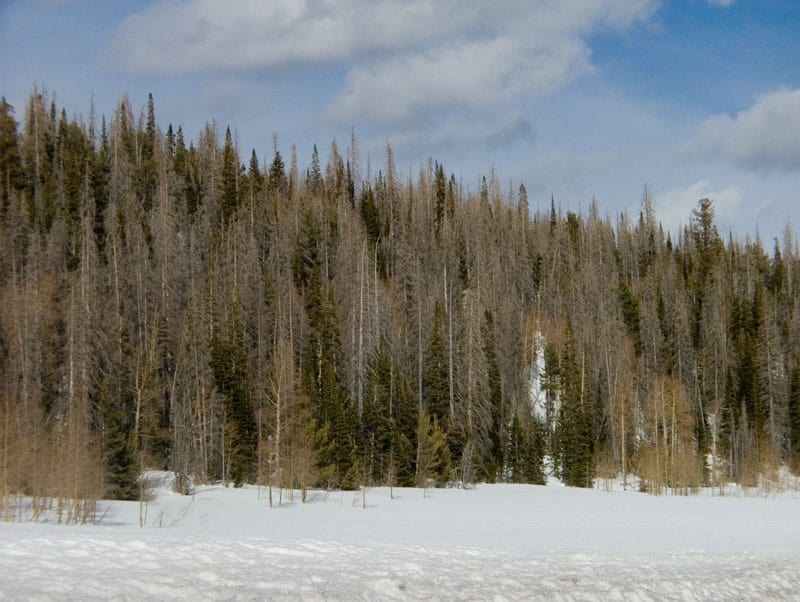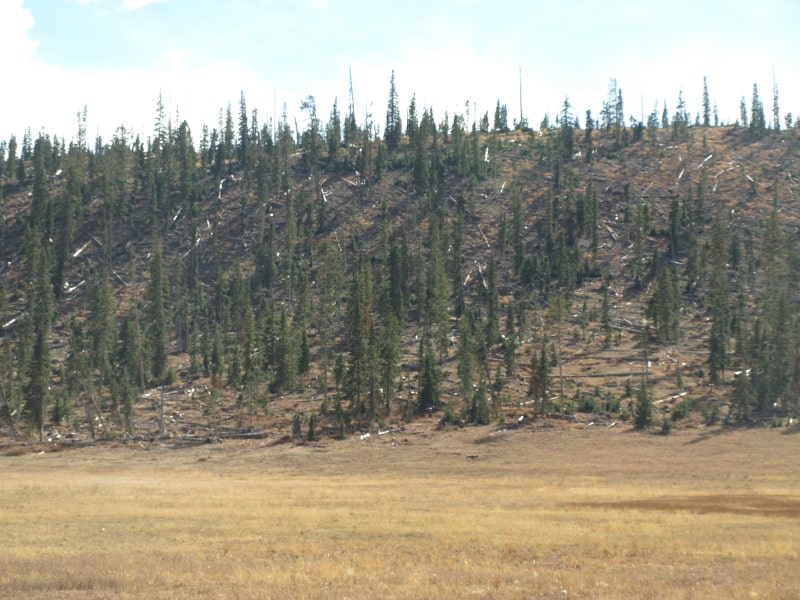In driving between Cedar City and Bryce Canyon, I was struck at the severe mortality from bark beetles. Here is what I saw the first time. The entire area had severe bark beetle mortality, with surviving aspen trees. I really doubt that any green trees were cut, as the bark beetles were still busily chewing and doing their thing.
The next time I drove through, I saw where snags had been felled and removed, resulting in this scene. I’m guessing that they skidded the logs over the snow, or used a helicopter. My bet is on over-the-snow skidding. This area is right at the summit, where the intersection to Cedar Breaks is. There are homes on the other side of the ridge. I like what they did here.


FWIW, I do too.
On the other hand, it looks like a lost opportunity to have some fine black-backed woodpecker habitat on the landscape. What looks like a mess to humans, might look like a feast to black-backed woodpeckers.
“The black-backed woodpecker appears to fill a niche that describes everything that foresters and fire fighters have attempted to eradicate. For about the last 50 years, disease and fire have been considered enemies of the ‘healthy’ forest and have been combated relatively successfully. We have recently (within the last 0 to 15 years) realized that disease and fire have their place on the landscape, but the landscape is badly out of balance with the fire suppression and insect and disease reduction activities (i.e. salvage logging) of the last 50 years. Therefore, the black-backed woodpecker is likely not to be abundant as it once was, and continued fire suppression and insect eradication is likely to cause further decline.”
Cherry, M.B. 1997. The Black-Backed And Three-toed Woodpeckers: Life
History, Habitat Use, And Monitoring Plan. Unpublished Report on file
with U.S. Department Of Agriculture, Lewis And Clark National Forest,
P.O. Box 869, Great Falls, Mt 59403. 19 pp.
There IS no lack of black-backed woodpecker habitat, across most of the west, due to, oh, about a BILLION dead trees. With that sheer amount of trees, you would think the woodpeckers would be more common than ravens. AND, there will be no lack of habitat, either, due to the coming firestorms and further barkbeetle infestations that follow the blazes. The real facts are that there was MUCH less habitat, when Indians did their widespread cool burns, clearing out many standing snags. More spin from an anonymous Tree.
In the case of this area, again, there is NO lack of snags, until they fall down in a jack-strawed heap. Yes, birds CAN, and DO fly to their next meal, just like in the old days. The biggest danger to woodpeckers, like other birds, is catastrophic wildfires which removes all trees, for decades.
AND, a 1997 study doesn’t include the massive die-offs we have had, including the dead trees in the first picture.
I like what they did, too, but I think they left too much large woody debris on the ground. I think an additional step of removing the remaining large dead wood off the ground, followed by a broadcast burn when sufficient ground cover had grown, would make this stand a lot safer and more pleasant to visit by adjacent landowners. More productive for wildlife, too, at least the types of species most people are interested in.
And yes, if dead trees and habitat modeling are in accord, we should be witnessing a giant outbreak of black backed woodpecker flocks by this time.
Interestingly enough, setting aside vast snag patches for the blackbacked woodpecker in SW Utah would be quite ineffective, since the bird DOES NOT LIVE in any part of Utah!! (smirks)
Broadcast burning beneath thin barked species such as spruce, lodgepole pine, and subalpine fir is usually not advisable if you want to retain green trees. Thin bark can not take much heat and spruce has a shallow root system that likes the organics in the upper soil profile. I do like the results of the salvage, but I’d be curious if there is any lodge pole regeneration.
Mike: I agree — especially if there is as much fuel on the ground as now seems in place. Lightning or careless smoking could girdle much of this stand, whether a fire crowns or not.
I would prep the site as clean as possible around the leave trees, let some grass or weeds grow between the trees for a year or so, and then burn, with a fuel load of just a few tons per acre and the heaviest fuels concentrated in openings away from leave trees.
Different specs for different species, but fire is usually the cheapest, most effective way to get rid of scattered debris and litter. Best access for people and wildlife, too.
Fotoware: Not sure I’ve the right spot from your description, but is this the lat/long? 37.592155275073374,-112.88883780323795
Near the Cedar Canyon Campground? At about 9,000 feet elevation?
My picture point is centered here:
http://maps.google.com/maps?hl=en&ll=37.570909,-112.834933&spn=0.014541,0.033023&t=h&z=16
I parked at the intersection of Highways 148 and 14. Additionally, impacts from the big die-off include a HUGE slide of Highway 14, east of the summit. A few hundreds yards of the highway slid downhill, last year. I’m not sure if they have it fixed yet. As of October, it was still closed. Highway 14 is a spectacular route, with interesting combinations of varied forests and geology.